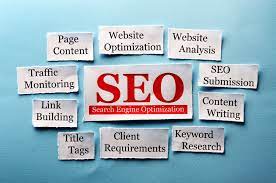Site Optimization: Boosting Performance and User Experience
In today’s fast-paced digital world, having a well-optimized website is crucial for businesses and individuals alike. Site optimization involves various techniques and strategies aimed at improving the performance, speed, and user experience of a website. In this article, we will explore the importance of site optimization and some key practices to implement.
Why is Site Optimization Important?
Improved Loading Speed: One of the primary goals of site optimization is to enhance the loading speed of web pages. Studies have shown that users tend to abandon websites that take too long to load. By optimizing your site, you can ensure that visitors have a seamless browsing experience, reducing bounce rates and increasing engagement.
Enhanced User Experience: A well-optimized website provides a positive user experience by offering easy navigation, clear content layout, and intuitive design. When users can effortlessly find what they are looking for, they are more likely to stay on your site longer, explore more pages, and potentially convert into customers.
Better Search Engine Rankings: Search engines prioritize websites that offer a great user experience and fast loading times. By optimizing your site, you improve its chances of ranking higher in search engine results pages (SERPs). This can lead to increased organic traffic and visibility for your business or personal brand.
Key Practices for Site Optimization
Compress Images: Large image files can significantly slow down a website’s loading speed. Optimize your images by compressing them without compromising their quality. Use image editing tools or plugins to reduce file sizes before uploading them to your website.
Minify CSS and JavaScript: Minification is the process of removing unnecessary characters, spaces, and line breaks from CSS and JavaScript files. This reduces their file sizes, allowing them to load faster. There are online tools and plugins available to automate this process.
Enable Browser Caching: Browser caching allows elements of your website to be stored in a visitor’s browser, reducing the need to download them again on subsequent visits. By setting appropriate caching headers, you can improve loading speed for returning visitors.
Optimize Code and Scripts: Clean and efficient code is essential for site optimization. Remove any unused code, eliminate render-blocking scripts, and optimize your HTML, CSS, and JavaScript files to ensure faster rendering by browsers.
Use Content Delivery Networks (CDNs): CDNs distribute your website’s static content across multiple servers worldwide. This reduces latency by serving content from a server closer to the user’s location. Implementing a CDN can significantly improve page load times for visitors across different geographical regions.
Mobile Optimization: With the increasing use of mobile devices for browsing, optimizing your website for mobile is crucial. Ensure that your site is responsive, meaning it adapts seamlessly to different screen sizes and resolutions. Mobile-friendly sites not only provide better user experiences but also rank higher in mobile search results.
In Conclusion
Incorporating site optimization practices into your web development strategy is vital for achieving optimal performance, improved user experience, and higher search engine rankings. By prioritizing site optimization techniques such as image compression, code minification, caching, and mobile optimization, you can create a fast-loading website that engages users and drives business success.
Unlocking Website Potential: 8 Essential FAQs on Site Optimization
- What is site optimization?
- Why is site optimization important?
- How does site optimization improve loading speed?
- What are the key factors that affect website performance?
- What are some common techniques for optimizing images on a website?
- How can I improve mobile optimization for my website?
- What is browser caching and how does it help with site optimization?
- Are there any tools or plugins available to assist with site optimization?
What is site optimization?
Site optimization refers to the process of improving a website’s performance, speed, and user experience. It involves implementing various techniques and strategies to enhance the loading time, navigation, and overall functionality of a website. Site optimization aims to create a seamless browsing experience for visitors by optimizing elements such as images, code, scripts, and server configurations. By optimizing a website, businesses and individuals can improve their search engine rankings, attract more organic traffic, reduce bounce rates, and increase user engagement. Ultimately, site optimization plays a crucial role in ensuring that websites are efficient, user-friendly, and competitive in the digital landscape.
Why is site optimization important?
Site optimization is crucial for several reasons. Firstly, it improves the loading speed of a website, ensuring that visitors have a seamless browsing experience and reducing bounce rates. Secondly, it enhances the overall user experience by providing easy navigation, clear content layout, and intuitive design. A well-optimized site increases user engagement and the likelihood of conversions. Additionally, site optimization plays a significant role in search engine rankings. Search engines prioritize websites that offer a great user experience and fast loading times, leading to increased organic traffic and visibility. Overall, site optimization is essential for maximizing performance, attracting more visitors, and achieving business or personal goals online.
How does site optimization improve loading speed?
Site optimization plays a crucial role in improving the loading speed of a website. By implementing various techniques such as compressing images, minifying CSS and JavaScript files, enabling browser caching, optimizing code and scripts, and utilizing content delivery networks (CDNs), site optimization reduces the file sizes and enhances the efficiency of web page elements. This results in faster loading times as unnecessary data is eliminated, rendering is expedited, and content is delivered more efficiently to users’ browsers. Ultimately, site optimization ensures a seamless browsing experience by reducing loading times, minimizing user frustration, and increasing engagement on the website.
What are the key factors that affect website performance?
Website performance can be influenced by several key factors. One crucial factor is the website’s hosting infrastructure, including the server’s processing power and available resources. The size and complexity of a website’s files, such as images, scripts, and CSS, also impact performance. Additionally, efficient coding practices play a significant role in optimizing website performance. The number of HTTP requests made when loading a page, as well as the use of caching mechanisms and content delivery networks (CDNs), can greatly affect loading speed. Lastly, factors like network latency and the user’s device and internet connection speed can impact overall website performance. By considering these key factors and implementing appropriate optimization techniques, website owners can enhance their site’s performance for a seamless user experience.
What are some common techniques for optimizing images on a website?
When it comes to optimizing images on a website, there are several common techniques that can significantly improve site performance. One technique is image compression, which reduces the file size of images without compromising their quality. This helps to minimize loading times and bandwidth usage. Another technique is using the appropriate image format, such as JPEG for photographs and PNG for graphics with transparency. Additionally, implementing lazy loading allows images to load only when they become visible on the user’s screen, further enhancing page loading speed. Lastly, specifying image dimensions in HTML helps browsers allocate space for the image before it fully loads, preventing layout shifts and improving overall user experience. By employing these techniques, website owners can ensure that their images are optimized for fast and efficient delivery without sacrificing visual appeal.
How can I improve mobile optimization for my website?
To improve mobile optimization for your website, there are several key steps you can take. Firstly, ensure that your website is responsive, meaning it automatically adjusts its layout and content to fit different screen sizes and resolutions. This allows for a seamless user experience across devices. Additionally, optimize your images by compressing them without compromising quality to reduce loading times on mobile devices. Minify CSS and JavaScript files to reduce their file sizes and improve loading speed. Implement touch-friendly elements and intuitive navigation to enhance usability on mobile devices. Lastly, regularly test your website on various mobile devices and screen sizes to identify any issues or areas for improvement. By implementing these practices, you can create a highly optimized mobile experience for your website visitors.
What is browser caching and how does it help with site optimization?
Browser caching is a technique used in site optimization that allows certain elements of a website to be stored in a visitor’s browser. When a user visits a website for the first time, their browser downloads all the necessary files, such as HTML, CSS, JavaScript, and images. With browser caching enabled, these files are then stored locally on the user’s device. When the user revisits the website or navigates to another page within the same site, their browser can retrieve these cached files instead of downloading them again. This significantly reduces loading times and improves site performance since the browser doesn’t need to make additional server requests for static content. By implementing browser caching, websites can enhance user experience and optimize their overall site speed, leading to increased visitor satisfaction and potentially higher search engine rankings.
Are there any tools or plugins available to assist with site optimization?
Yes, there are numerous tools and plugins available to assist with site optimization. These tools can help streamline the optimization process by automating tasks such as image compression, code minification, browser caching, and more. Some popular tools include Google PageSpeed Insights, GTmetrix, and Pingdom. Additionally, content management systems like WordPress offer a wide range of plugins specifically designed for site optimization. These tools and plugins provide valuable insights and recommendations to improve your website’s performance, speed, and user experience. Whether you’re a beginner or an experienced developer, utilizing these tools can greatly enhance your site optimization efforts.




